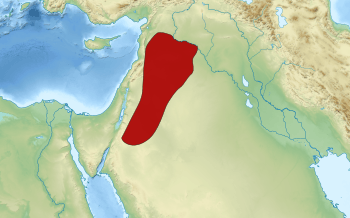Tanukhids facts for kids
Quick facts for kids
Tanukh
تنوخ
|
|||||||||||||
|---|---|---|---|---|---|---|---|---|---|---|---|---|---|
| 196 AD–c. 1100 AD | |||||||||||||
 |
|||||||||||||
| Capital | Qinnasrin (main base) | ||||||||||||
| Common languages | Arabic | ||||||||||||
| Religion | Arab Paganism, Christianity, Islam | ||||||||||||
| Demonym(s) | Tanukhi | ||||||||||||
| Government | Chiefdom | ||||||||||||
| Chief/King | |||||||||||||
|
• 196–231 AD
|
Malik ibn Fahm | ||||||||||||
|
• 233–268 AD
|
Jadhima ibn Malik | ||||||||||||
|
• Until 375 AD
|
al-Hawari | ||||||||||||
| Historical era | Classical Age to the Early Middle Ages | ||||||||||||
|
• Established
|
196 AD | ||||||||||||
|
• Conversion to Christianity
|
3rd or 4th century | ||||||||||||
|
• Revolt of Queen Mavia
|
378 AD | ||||||||||||
|
• Conversion to Islam
|
8th century | ||||||||||||
| 1096–1099 AD | |||||||||||||
|
• Disestablished
|
c. 1100 AD | ||||||||||||
|
|||||||||||||
The Tanukhids (Arabic: التنوخيون) or Tanukh (Arabic: تنوخ) were a group of Arab tribes that joined together. They were sometimes called Saracens. They became well-known in northern Arabia and southern Syria around the 3rd century BC.
You can find writings from both the Tanukhids and another group called the Lakhmids in places like Umm el-Jimal in Jordan. The Tanukhids were later joined by parts of the large Azd and Quda'a tribes. Their main home when their most famous leader, Queen Mavia, ruled was in Aleppo. Later, in the 8th and 9th centuries, their main cities were Qinnasrin and Maarat al-Numan.
Contents
History of the Tanukhids
Early Beginnings and Leaders
In the late 2nd century, a group from the Azd tribe moved from Southern Arabia to al-Hasa. This is where the Tanukhids were living. The Azd people became allies with the Tanukhids, joining their group.
Two tribal leaders gave control to Malik ibn Fahm, who ruled from 196 to 231 AD. He led them into what is now Iraq and Syria. After some fights with other tribes, he controlled all of Jordan and parts of Iraq.
His brother, 'Amr ibn Fahm, ruled for a short time after him. Then Jadhima ibn Malik became the leader, ruling from 233 to 268 AD. Since Jadhima had no sons, his nephew, 'Amr ibn Adi, took over after him. 'Amr ibn Adi was from the Lakhmid family, which started the Lakhmid dynasty.
Other Tanukhids settled in Syria. Stories say that 'Amr ibn 'Adi was the only one to win a war against Zenobia's Palmyrene Empire. While these stories mix facts with fiction, it's clear that the Tanukhids helped Emperor Aurelian defeat Zenobia's forces.
Allies of the Roman Empire
In the 4th century AD, the Tanukhids became the first Arab tribe to serve as foederati for the Roman Empire. This means they were special allies who helped the Romans. Their land stretched from Syria in the north down to the Gulf of Aqaba. They had moved to these areas from southern Arabia about a hundred years earlier.
The Tanukhids were known for being very dedicated to Christianity. They followed the teachings of Thomas the Apostle and were involved in monasticism, which is a way of life where people live in monasteries and dedicate themselves to religious practices. Many monasteries were connected to their tribe.
In 378 AD, their queen, Queen Mavia, led them in a revolt against the Roman Emperor Valens. They made a peace agreement, which lasted for a while. Queen Mavia even sent her cavalry (soldiers on horseback) to help the Romans fight off an attack by the Goths. However, this alliance broke apart under Emperor Theodosius I, and the Tanukhids rebelled against Roman rule again.
Changing Faiths: Christianity to Islam
The Tanukhids became Christians in the 3rd or 4th centuries. This likely happened when they were in the eastern part of the Fertile Crescent. By the 4th century, people said they had a "fanatic zeal for Christianity" and were "zealous Christian soldiers" in the 6th century.
In the 7th century, during the Muslim conquest of the Levant, the Tanukhids fought alongside the Romans against the Muslims. They were part of the Battle of Yarmouk. After this battle, their role as Roman allies ended.
They were an "autonomous Christian community" in Bilad al-Sham (a region that includes modern Syria, Jordan, Lebanon, and Palestine) until the rule of the Abbasid caliph al-Mahdi (who ruled from 775 to 785 AD). After this time, they started to appear as Muslims. It is believed that al-Mahdi forced them to convert to Islam.
Later History and the Druze Community
In the 11th century, other tribes from southern Arabia, like the Banu Ma'an, joined the Tanukhids. The Tanukhids of Mount Lebanon were important in starting the Druze community in Lebanon. Many of them accepted the new Druze faith because their leaders had strong ties with the Fatimid caliph al-Hakim bi-Amr Allah.
The Ma'an tribe settled in the Lebanon Mountains. The governor of Damascus ordered them to live there to protect against the Crusaders who were moving into the area. Most Ma'ans in Lebanon later became Druze. They were later defeated by a rival Druze tribe called the Qaysi Druze. The central parts of Mount Lebanon were a Tanukhid stronghold, where both Druze and Shiite Muslims lived until the early 14th century.
See also
 In Spanish: Tanújidas para niños
In Spanish: Tanújidas para niños

